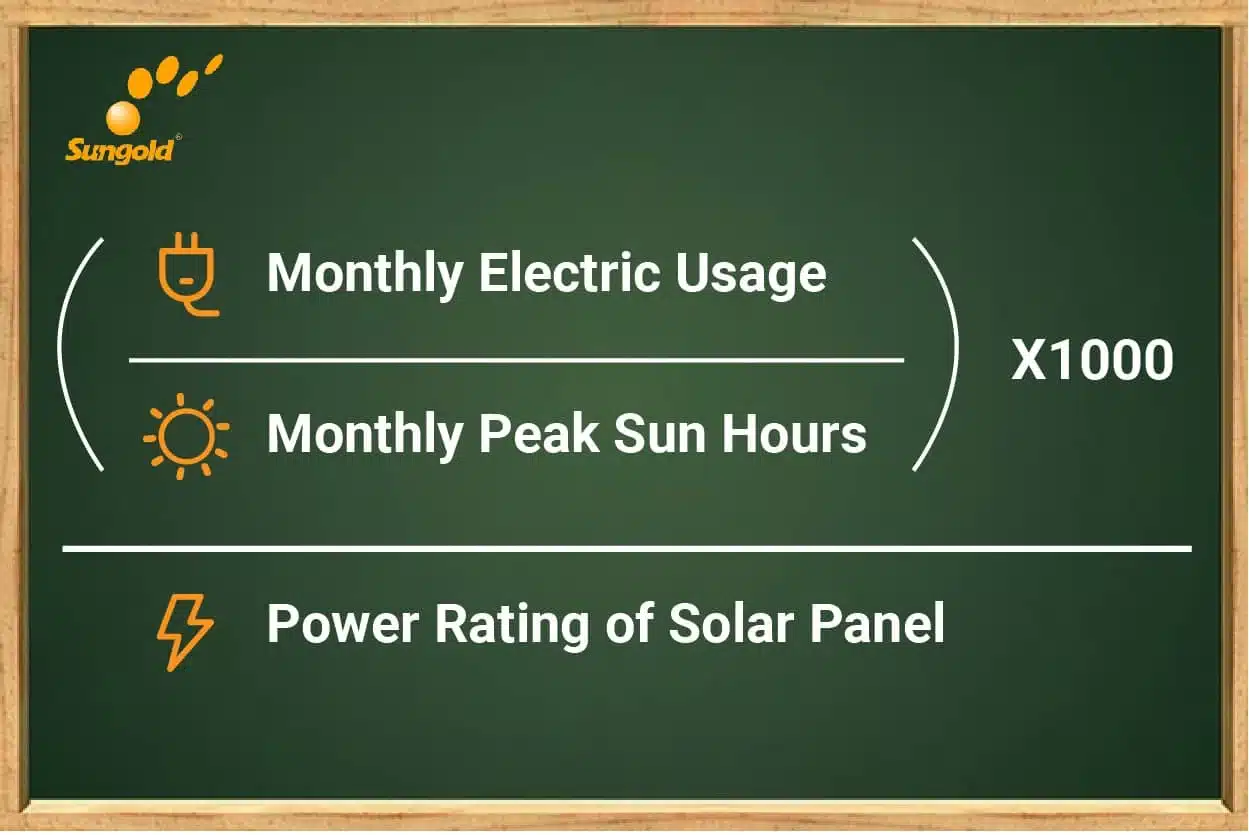Going off-grid is a significant decision, offering both independence and sustainability. One of the critical steps in achieving an off-grid lifestyle is determining how many solar panels you need to generate sufficient power. This article will guide you through understanding the requirements for an off-grid solar system, including the size of the solar array, energy consumption calculations, and how Sungold solar panels can help power your home or property sustainably.
What is Off-Grid?
Being off-grid means not being physically connected to public utilities via wires, pipes, or cables. Therefore, off-grid homes rely entirely on their own energy sources, which are often renewable, such as solar or wind power. When a building is off the grid, it means it has no physical connection or relationship with any type of utility, and all the electricity it uses comes from the energy it generates and stores itself.
Achieving energy self-sufficiency is a key part of living off-grid, and this involves not being physically connected to energy utilities. As a result, those who choose to live off-grid and not rely on utility power must generate their own energy for heating, cooking, and communication by installing their own solar panels, wind turbines, or on-site generators.
Thanks to modern technology, living off-grid with energy self-sufficiency is relatively easy today. One of the most common power sources for those who choose to live off-grid is a solar power system, which consists of photovoltaic panels that absorb and generate energy from the sun, along with batteries to store that energy for use when there is no sunlight.
Can I Go Off-Grid with Solar Panels?
When it comes to generating your own electricity, there’s arguably no greener or more efficient technology than solar panels. In most cases, it is 100% possible to go off-grid using solar panels. However, this is only a small piece of the puzzle.
To maintain a sustainable, long-term off-grid lifestyle, you’ll need somewhere to store all the solar energy that your panels generate. Just as solar panels are the most accessible and efficient way to produce electricity, solar batteries or solar power stations are by far the best technology for storing off-grid solar energy.
So, essentially, you can indeed go off-grid using solar panels along with some form of storage system.
What Size Solar System Do I Need To Go Off-Grid?
The size of the solar system you need depends on several factors, including your energy consumption, location, and available sunlight. An off-grid solar system should be capable of meeting all your power needs without relying on external sources.
Factors to Consider:
Energy Usage: Understanding how much energy you consume is the first step in determining the size of your solar system. Typically, homes use 300-500 kWh per month, but this can vary based on the number of appliances, lighting, heating/cooling needs, and other electrical devices.
Location: The amount of sunlight your area receives plays a crucial role. Areas with more sun hours will need fewer solar panels compared to regions with frequent cloud cover or shorter days.
System Efficiency: A high-efficiency solar panel, such as Sungold solar panels, can significantly reduce the number of panels you need. Sungold panels are known for their durability and high energy output, making them ideal for off-grid applications.
How Many kWh Do I Need To Be Off-Grid?
To determine how many kWh (kilowatt-hours) you need to go off-grid, start by assessing your daily energy consumption. Here’s how you can calculate it:
Steps to Calculate Daily Energy Consumption:
Identify Your Appliances: List all appliances and devices you use regularly and their power ratings (usually found on labels). Common devices include lights, refrigerators, washing machines, and heating/cooling systems.
Estimate Usage: Multiply the wattage of each appliance by the number of hours it is used daily. For example, if a 100-watt light bulb runs for 5 hours a day, it uses 500 watt-hours (0.5 kWh) of energy.
Total Energy Consumption: Add up the energy usage of all your appliances to find your total daily consumption in kilowatt-hours.
For a household consuming approximately 10 kWh per day, you would need to ensure your solar system can generate this amount of energy each day.
How many solar panels do I need to go off-grid?
The number of solar panels required for off-grid living depends on your daily energy consumption and the output of each panel. Here’s a basic approach to determine how many panels you need:
Calculate Daily Energy Consumption: As mentioned earlier, you need to estimate your daily energy usage in kWh.
Determine Solar Panel Output: The typical Sungold 12V 30W solar panel generates about 0.9 kWh per day under optimal sunlight conditions (assuming 5 hours of sunlight per day). Larger panels, like Sungold 100W or 200W models, will generate more energy per day, which is beneficial if you have high energy consumption.
Estimate the Number of Panels: Divide your daily energy consumption by the energy generated by one panel to determine the number of panels needed. For instance, if you consume 10 kWh per day and each Sungold 30W panel generates approximately 0.9 kWh, you would need around 11 panels.
Example Calculation:
If you use 10 kWh of energy daily, and each Sungold 100W panel generates 4 kWh per day:
- 10 kWh ÷ 4 kWh = 2.5 panels
- Round up to 3 panels for a more reliable power supply.

How to Calculate How Many Solar Panels You Need
Step 1 – Calculate Your Energy Usage
Most energy bills display the kilowatt hours (kWh) used, usually at the bottom of the statement, multiplied by the cost of electricity.
Step 2 – Calculate the Amount of Sunlight Your Location Receives
Peak sunlight hours are the hours when the sun produces an average of 1000 watts per square metre. In summary, peak sunlight hours represent the period during which the sun is at its most powerful, allowing solar panels to operate at maximum productivity.
Step 3 – Calculate the Size of the Solar System You Need for Off-Grid Living
First, you need to calculate the average number of peak sunlight hours in a month. Simply multiply the daily peak sunlight hours by 30.
Step 4 – Calculate How Many Solar Panels You Need to Go Off-Grid
The first thing you need to do is convert the solar system size from kilowatts to watts by multiplying the system size by 1000. To determine how many solar panels you need, you now need to decide how many watts each solar panel will generate.
Example:
If you consume 12 kWh daily and use Sungold 100W solar panels, which generate 4 kWh per day:
- 12 kWh ÷ 4 kWh = 3 panels
- Add 30% for efficiency losses: 3 × 1.3 = 4 panels.
In this example, 4 Sungold 100W solar panels would meet your needs.
Can You Live Completely Off-Grid with Solar Panels?
Yes, it is possible to live completely off-grid with solar panels, but it requires careful planning and the right equipment. Living off-grid means you won’t have access to the grid for backup power, so your solar system needs to be designed to handle all your energy needs. This is where having a reliable, high-quality solar panel system like Sungold solar panels is essential. Sungold’s solar solutions are designed to efficiently store energy for long periods, ensuring that you have a stable power supply, even when the sun isn’t shining.
Key Considerations for Off-Grid Living:
Energy Storage: Along with solar panels, you will need a reliable battery storage system to store excess energy produced during the day for use at night or during cloudy periods.
Energy Efficiency: Off-grid living also requires reducing your energy consumption as much as possible. Opt for energy-efficient appliances, LED lighting, and smart power management to make the most of your solar system.
Backup Power: Depending on your location and energy needs, you may need a backup generator to ensure you have power during long stretches of bad weather.
Final Thoughts
I hope you now have a clear understanding of the entire process involved in determining the number of solar panels needed for an off-grid system. Ultimately, factors such as your energy consumption, the available roof space, the amount of direct sunlight received each day, and the type of solar panels you choose all play a role in deciding how many panels you will need.
If you’re planning a shorter off-grid camping trip, we recommend trying smaller solar panels along with energy storage to keep you powered up throughout your adventure.
Key Points to Remember:
- Energy consumption and solar panel output are the key factors in determining how many panels you need.
- Sungold solar panels are a reliable and efficient option for off-grid living, offering a range of sizes to suit different energy needs.
- Always account for energy storage and backup power to ensure a steady power supply.
- Don’t forget to include efficiency losses in your calculations to ensure your system is reliable.
With a well-sized solar system and Sungold solar panels, you can confidently transition to an off-grid lifestyle, reducing your reliance on traditional power sources and embracing sustainable energy solutions.







